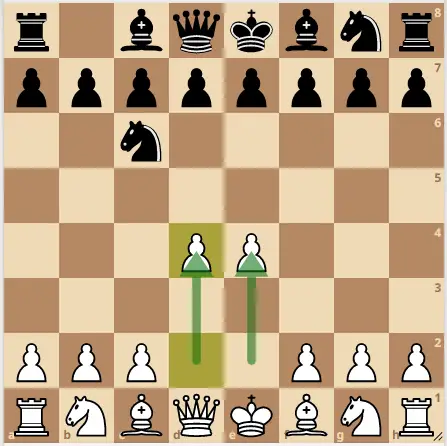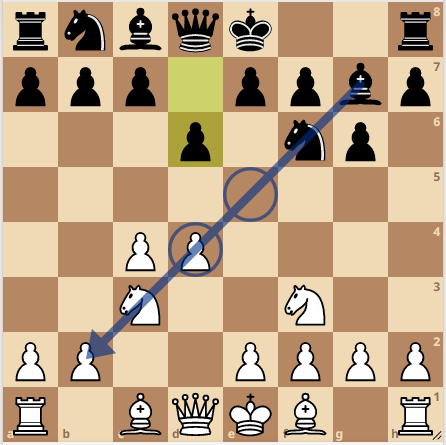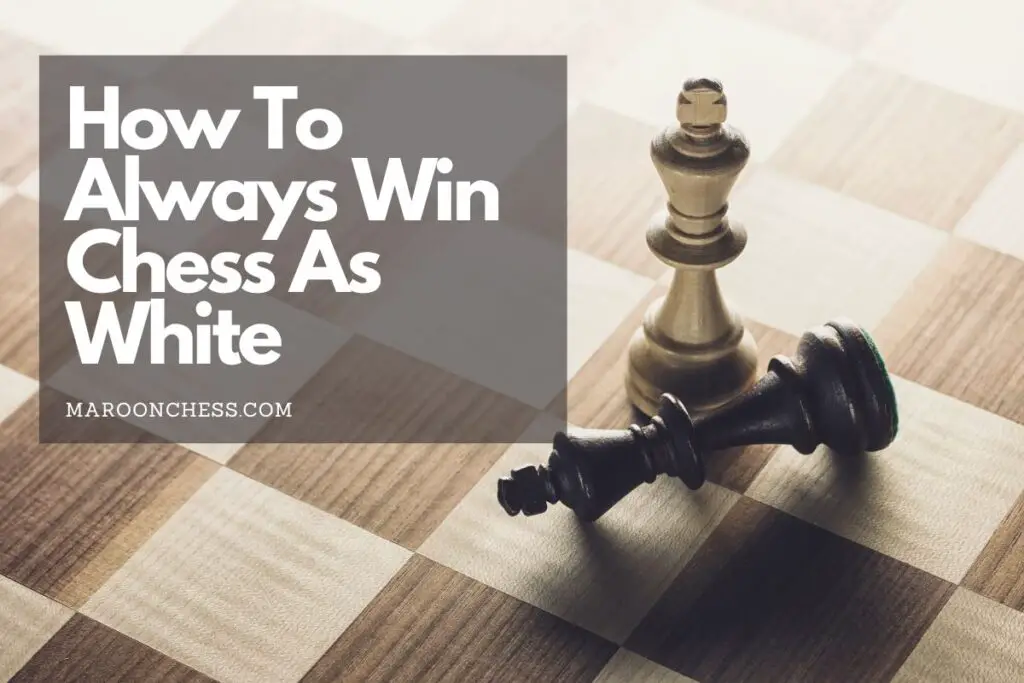One of the secrets to always winning chess as white is to come up with an effective plan. Without a clear plan, you will make a lot of mistakes in your games. The goal is not to find the right moves, but the right plan. When you construct a winning plan, you naturally find the right moves in the position and you are less likely to blunder.
In this article, I will reveal 6 helpful tips that will allow you to win chess as white. Make sure you read all 6 tips as each one is just as important as the other. With said, let’s jump right in.
How to always win chess as white:
1. Control The Center Of The Board
If you want to always win chess as white, you need to take control of the center as early in the opening. Your pieces control more squares from in the center, and moving your pawns to the central squares help to open lines for your pieces.
You can take control of the center directly by occupying it with pawns, or you can go for the hyper modern approach of controlling the center from a far.
Whichever strategy you choose, it’s important that your play revolves around the center. The fight for the center is one of the most ancient positional concept in chess history and is still considered the most effective strategy in today’s era.
The Classical Approach
The classical approach to playing in the center is to simply advance your d and e pawns forward so that they control key squares in the center. Placing your pawns in the center can hinder the development of your opponent’s pieces while increasing the activity of your own pieces as it open lines for your bishops.
Advance your central pawns forward

Apart from the d and e pawns, the c and f pawns also help to control the center. However, you should be careful when pushing the f pawn as it creates weaknesses around your king.
The Hyper-Modern Approach
The hyper modern approach achieves the same objective of controlling the center. However, the pieces stay from a far to control the center rather than occupying it.
The most common method is to fianchetto your king’s bishop along the long diagonal. This not only helps to control the center, but it activates your bishop to a great extent than if it was typically developed in the classical fashion.

All in all, control of the center is critical if you wish to gain any winning advantage over your opponent.
2. Stick To One Opening (e4 or d4), But Not Both
The law of diminishing returns can apply to chess. Pawn to d4 in itself encompasses a whole family of openings and responses you need to know if you truly want to become a master of the queen’s pawn opening.
Similarly, if you are playing e4, you need to be prepared for all of black’s responses which can include the French Defense, Scandinavian Defense, Pirc, and not to mention the Sicilian Defenses which contain a large catalogue of other openings.
Therefore, it would be a lot difficult for you to master e4 if you persist on playing d4 as well. This can actually hurt your progress as you dedicate more of your time to learning a whole new repertoire.
It’s best to stick to one opening and dive deeper into the different variations of that single opening rather than learning several other openings.
I’ll be more scared of the guy who has played 10,000 games with the king’s indian defense, than the guy who has played 10,000 games with the KID, Sicilian, French, Pirc, Dutch, Queen’s Gambit Decline, Benoni, and Scandinavian altogether.
The point is that you should not overwhelm yourself with learning and playing new openings. Don’t get me wrong, it’s good to know different openings as you get exposed to new positions and strategies you never once knew. But when it comes to competitive matches, it’s good to have a single impenetrable repetoire that is difficult to crack.
What Opening Is Best For Me?
The choice between e4 or d4 will depend on the type of chess player you are. If you see yourself as an attacking player, and one who wishes to gain an advantage as early in the opening, then e4 is probably best suited for you.
Most e4 openings are sharp, cut throat and clinical unlike d4 which is often slow and positional. Therefore, if you are that kind of person who feels that they need to end the game as quickly as possible, your best bet is e4.
However, if you are a sound positional player who prioritize strategy and deep positional understanding, then d4 is the opening for you. Queen’s pawn opening are for those who have good positional knowledge of chess and can slowly but surely outplay their opponent to victory.
3. Don’t Let Black Neutralize The Position
In competitive matches, the player with the black pieces is always seeking to neutralize the position, as white is the one who usually has the upper hand in development since white goes first.
Black will try to neutralize the position with pawn breaks in the center in order to get the evaluation down to 0:0.
He can also trade off the pieces and go into an equal endgame.
Neutralizing the position helps take away any advantage or initiative for white and gives black excellent drawing chances. Yes, in competitive chess, the player with the black pieces is happy to walk away with a draw since ‘theoretically’ white is the one who stands better winning chances.
So how do you prevent black from neutralizng the position? This brings us to our next point…
4. Keep The Tension
Keeping the tension is by far the number one strategy in winning most of your games as white and to beating stronger opponents.
It’s simple logic, if you keep your pieces on the board long enough, then you have more of a chance to attack your opponent. But if you trade off your pieces, then you don’t have any chances of attacking your opponent and so the game would most likely result in a draw.
Another great benefit of keeping the tension is that your opponent starts to get nervous. The more you keep the tension on the board is the more your opponent has to calculate and the more he gets nervous. The likelihood of him making a blunder increases as he becomes unsettled in his seat.
Eventually most of them crack and make silly blunders due to the pressure that they are under. This is even worse if they are rated higher than you as more pressure is placed on them to win.
So how do you keep the tension on the board?
Tension is when pieces and pawns come in contact with each other. Capturing a piece is called “releasing the tension”, but you don’t want to do that as the more pieces are exchanged, the less tension there is and the likelihood of drawing.
To keep the tension on the board:
- Avoid trading pieces
- Use your pieces to make contact with your opponent’s pieces
When do you release the tension?
You release the tension when you have a clear objective in mind. For example, to execute a tactical combination that wins material at the end of the line or to gain a superior positional advantage over your opponent. You can also exchange your pieces and go into a winning endgame, but only if you are certain that the endgame is winning.
5. Calculate Properly
If you want to always win at chess, then you need to hone your calculation skills. The player who is able to calculate deeply stands a greater chance of winning. It’s what separates the super GM’s from the rest of the pack. Players like Alireza Firouzja, Hikaru Nakamura, Magnus Carlsen and all the rest of 2700s can calculate up to 10 moves deep and even greater!
So why can these players calculate so deeply than the average Joe you may ask? Is it because they are born talented?
Well, it’s true that some part of it has to do with talent, but the majority has to do with how disciplined of a player you are. Are you willing to spend the time to look over all the forcing moves in the position? If you said no, then it could be the reason why you make so many blunders.
Grandmasters learn how to develop an effective system of thinking from a young age. It is embedded in their mind. They’ve trained themselves to think this way so that they don’t overlook moves that can cost them the game. Besides basic positional understanding of chess, sharpening your calculation skills is actually all there is to becoming a strong player.
So How Do You Calculate Properly In Chess?
In one of my articles, I went over how to effectively calculate in chess. But to give you a summary, here is what your thought process should be when calculating:
Study the position: Look for all the tactical elements in the position. For example: pins, loose pieces, potential skewers and forks, or any other tactical themes. Also, study the positional elements of the game as you would need to make a positional move if none of the tactical combinations don’t work.
Come up with 3 candidate moves: Once you’ve finished studying the position, it’s easier for you to list 3 candidate moves that comes to mind. These moves should be forcing. In other words, look for checks, captures, and attacks (in the exact order)
Look for your opponent’s forcing moves: When calculating each individual candidate move, you should always look for your opponent’s forcing response to your moves. Keep doing this until you’ve reached the end of the line when there are no more checks, captures or attacks, and all the smokes have cleared.
Assess the position: At the end of the line, did you gain material? If yes, you should play that move. If no, you should play a positional move instead that improves your position.
6. Develop a Winning Plan
Failure to come up with a plan often results in blunders. A player with no clear objective is like a leaf drifting in the river.
Moves become obvious and natural whenever you have an effective strategy or plan. This will help you win more games as white and also with black. But without a clear plan, you’ll resort to guessing and it will be very difficult to find the right moves. This often leads to “reactive chess” also known as impulsive chess. Your opponent makes a move and you immediately react to that move instead of focusing on the big picture.
Don’t get me wrong, it’s good to always stop your opponent from making threats and minimize their counterplay. But sometimes these threats are not real and can cost you valuable tempo. Let’s look at an example.

In this position, black just played the move pawn to h6. Perhaps black didn’t like the idea of the white knight jumping to g5. But with closer inspection, this was not actually a threat. If black would have developed his knight to f6 (which was the best move), Ng5 also known as the Fried liver attack would not be successful as black would have defended and equalized the position with pawn to d5 break (preventing any shenaningans on f7). Black is actually better here.
However, black played h6 which is an impulsive move. This gives white the opportunity to break in the center with the move pawn to d4! giving white a lead in development and space.
What Are The Different Plans In Chess
Your plan will depend on the nature of the position. Particularly the type of pawn structure that is present. There are three main pawn structures: static, open, and closed.
When the center is closed or static, generally your plan is to attack on either of the flanks. Especially on the side where most of your pieces are concentrated. Knights also thrive well in closed positions as they can get to certain squares by manoeuvring. Therefore, it’s a good idea to trade your bishop for a knight in closed positions.
On the other hand, when the position is open, you should retain your bishop pair as they become more powerful when lines begin to open up.
Conversely, if your opponent has the bishop pair in an open position, your plan is to trade off at least one of his bishops.
To learn more about the different plans in chess, see articles:
10 Effective Chess Strategies To Win
Best Chess Middlegame Strategy


